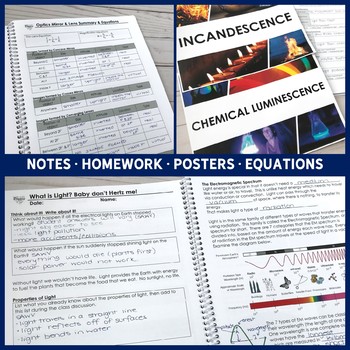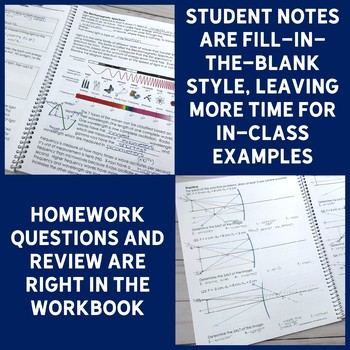OPTICS Workbook | Unit Notes on Light, Reflection, Refraction, Mirrors & Lenses
What educators are saying
Also included in
- Are you teaching Physics? Look no further – this growing bundle doesn't stop growing! As an active Physics teacher, I'm always adding new resources and once you've got this bundle you'll be getting all of those updates for free!I’ve bundled my Physics resources with a HUGE DISCOUNT! As I add morePrice $500.00Original Price $692.00Save $192.00
Description
This OPTICS Workbook is going to save you and your students so much time in your Physics and Science classes! This EDITABLE, 64-page workbook provides lessons and homework covering light, electromagnetic spectrum and types of EM waves, protecting yourself from the Sun's radiation, light production, properties of light, images in plane mirrors, curved mirrors including ray diagrams, refraction, index of refraction, total internal reflection, lenses including ray diagrams, the thin lens equation and the magnification equation. This workbook has been beautifully formatted in Microsoft Word, with all clear, crisp, custom graphics. Full solutions are included.
This workbook has an accompanying EDITABLE PowerPoint presentation! Check out the video preview above to see the PowerPoint presentation.
There is a 460-slide presentation that covers all lessons for the entire workbook (homework slides not included in slides, but full homework solutions are included in the PDF). The full presentation has also been divided by lesson into 15 shorter PowerPoint files that are quicker to load and easier to share with students during distance learning. A PDF version of each presentation is also included (great for sharing with students on your password-protected classroom management system).
The presentations come in 3 formats:
- editable PowerPoint
- "flattened" PowerPoint which can be uploaded to Google Slides with no change in formatting (OneDrive link included since these are large files)
This resource is part of my Growing Physics Bundle. If you like this style of organized note-taking I have other workbooks for Physics units:
1-Dimensional Kinematics workbook
2-Dimensional Kinematics workbook
Forces & Newton's Laws workbook
Momentum & Collisions workbook
Read the topics carefully to see if this workbook is right for you. The PREVIEW shows the watermarked solutions so you can examine if this workbook is right for you.
Students will learn about:
• light, as an electromagnetic wave and the different parts of the EM spectrum
• protecting yourself from the Sun's radiation
• how light is produced: incandescence, chemical luminescence (chemiluminescence), bioluminescence, fluorescence, phosphorescence, triboluminescence, radioluminescence, electric discharge, and light-emitting diodes (LEDs)
• properties of light (laws of reflection)
• images in plane mirrors
• curved mirrors: concave and convex mirrors
• ray diagrams for curved mirrors
• refraction, index of refraction
• total internal reflection
• lenses: converging and diverging lenses
• ray diagrams for lenses
• thin lens equation
• magnification equation
The Optics Workbook also includes:
• a title page
• an equation page and summary of images formed by concave and convex mirrors, and converging and diverging lenses
• a vocabulary page for students to update with key terms throughout the unit
• a preconception page, that asks probing questions at the beginning of the unit and it revisited at the end of the unit.
The zipped folder includes:
• The 64-page Optics workbook in PDF format and editable Microsoft Word format.
• Complete, handwritten solutions as a PDF file (64 pages).
• A 9-page PDF file of posters to accompany the Types of Luminescence lesson.
• 460-slides of lessons, that correspond to the lesson notes and the worked examples in the lessons. The homework problems are not included in the PowerPoint presentations, but their full solutions are included in the solutions PDF file.
Need a resource for vision problems? Check out Myopia and Hyperopia Doodle Notes.
This workbook is appropriate for AP Physics 2, SNC2D, and other Physics courses with an Optics unit.
How I use the workbooks
I have been using these workbooks with my Science and Physics students for years with great success. Students might be a little intimidated by the thickness of the workbooks at first, but they are VERY grateful when they see that these are mostly fill-in-the-blanks style with room for practice questions. I print them all out at the beginning of the unit and work through them day-by-day on the document camera. I try to get through one lesson per day. However, there are some longer lessons (like ray diagrams for mirrors and lenses) that are better split in two or three. I don’t like to instruct all class: I like to take up choice homework questions, infuse experiments into the day, have students work together and review previous concepts. I don’t mark the workbooks, but I do check them for completion. I assign homework from the workbook (which is usually done in class) and some additional homework problems from the textbook.
Let me address some of your questions…
Am I going to be photocopying every day?
Nope! I print off the ENTIRE workbook and give it to the students at the beginning of the unit. You can choose to bind it, staple it, or just hole-punch it for the students’ binders. I find most students like to keep the pages together. Grab a coffee, put your feet up and enjoy the sweet whirl of the photocopier.
Do you hate trees?
I feel very strongly that ray diagrams and calculations should not be done on the computer. By having the workbook printed you are saving your students lots of time and frustration trying to format equations on the computer. When one of your students solves the problem to sustainable energy via nuclear fusion we’ll both agree that this was worth the paper.
You use different variables than I do! What am I to do?
This workbook is editable in Microsoft Word. Yup. That’s how much I love you! If you or your textbook use a different notation, just edit it using the equation. The only things that are not editable are the graphics.
What about our textbooks?
I still use my textbooks for practice problems. Though there are plenty of practice problems in here, you may want to cycle some textbook problems in too. I like to print off one page at the beginning of the unit that has all the homework problems listed by section. By front-loading all the printing and choosing of the homework problems I save a lot of time throughout the unit.
I don’t teach everything that’s included (or I teach it in a different order), so…?
No problem – either delete those pages from the editable file or select only the pages you want while printing. No topics start mid-way through a page so it’s easy to remove something depending on the level of your students. If you teach it in a different order it’s a quick fix on the Print screen. Just type the page numbers in the order you want them, e.g. 1-24, 35-63, 25-34, 64
I need more Physics resources!
You should check out my Physics Growing Bundle. It’s my priority to add to this bundle, and it’s cost increases with each new resource I upload.
Are there labs in here?
No. No labs are included - consider these your students’ notes for the unit. I plan on adding more labs to the Growing Physics Bundle in the future. My Scientific Method: A Scientific Inquiry Unit is helpful for creating inquiry-based labs.
I’m a new Physics teacher, will this help me?
Absolutely, yes! I wish I had this when I started teaching Physics 10 years ago! This will save you a ton of time that you can use to grade tests, set-up labs and just keep your head above water.
Ontario teachers!
This workbook will cover most expectations in the Optics unit of the SNC2D course.
If you have any additional questions, feel free to Ask a Question here on TpT, or email me: mrs.brosseau@gmail.com
Save time planning for OPTICS by using these great resources:
Optics Workbook - Student Notes & Homework
FREE SAMPLE of Optics Task Cards
Thin Lens Equation and Magnification Lesson (PowerPoint + Note)
Thin Lens Equation and Magnification Punny Practice Page
Ray Drawing Diagram Templates for Curved Mirrors and Lenses.






